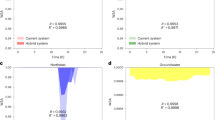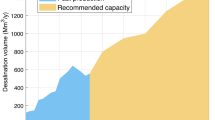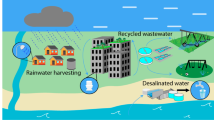Abstract
Water and wastewater infrastructure worldwide faces unprecedented demand and supply conflicts that require unconventional solutions. In this study, we develop a novel modelling framework to assess the environmental and economic implications of a hybrid water supply system that supplements a centralized surface water supply with distributed direct potable reuse (DPR) of municipal wastewater, as a strategy to address such challenges. The model is tested with real water and wastewater systems data from the City of Houston, Texas. Results show that supplementing the conventional centralized water supply with distributed DPR would reduce water age in the drinking-water distribution network and hence improve water quality; properly designed system configurations attain system-wide net energy savings even with the high energy consumption of existing technologies used for advanced treatment of the wastewater. A target energy efficiency for future advanced treatment technologies is identified to achieve net energy saving with all hybrid system configurations. Furthermore, distributed DPR remains financially competitive compared with other unconventional water supply solutions. The modelling framework and associated databases developed in this study serve an important research need for quantitatively characterizing distributed and hybrid water systems, laying the necessary foundation for rational design of integrated urban water systems.
This is a preview of subscription content, access via your institution
Access options
Access Nature and 54 other Nature Portfolio journals
Get Nature+, our best-value online-access subscription
$29.99 / 30 days
cancel any time
Subscribe to this journal
Receive 12 digital issues and online access to articles
$119.00 per year
only $9.92 per issue
Buy this article
- Purchase on Springer Link
- Instant access to full article PDF
Prices may be subject to local taxes which are calculated during checkout






Similar content being viewed by others

Data availability
The data that support the findings of this study are available from Houston Public Works, but restrictions apply to the availability of these data, which were used under license for the current study and so are not publicly available. Data are, however, available from the authors upon reasonable request and with permission of Houston Public Works.
Code availability
The software and custom-developed code for this study are available from the corresponding author upon request.
References
Daigger, G. T. Wastewater management in the 21st century. J. Environ. Eng. 133, 671–680 (2007).
Stillwell, A. S. et al. An integrated energy, carbon, water, and economic analysis of reclaimed water use in urban settings: a case study of Austin, Texas. J. Water Reuse Desal. 1, 208–223 (2011).
National Research Council; Division on Earth and Life Studies; Board on Toxicology and Environmental Health Hazards; Commission on Life Sciences; Safe Drinking Water Committee in Drinking Water and Health Vol. 4, Ch. 5 (National Academies Press, 1982); https://doi.org/10.17226/325
Mcallister, T. Developing Guidelines and Standards for Disaster Resilience of the Built Environment: A Research Needs Assessment Technical Note 1795 (NIST, 2013).
Hejazi, M., Edmonds, J., Chaturvedi, V., Davies, E. & Eom, J. Scenarios of global municipal water-use demand projections over the 21st century. Hydrol. Sci. J. 58, 519–538 (2013).
Hanasaki, N. et al. A global water scarcity assessment under Shared Socio-economic Pathways—part 1: water use. Hydrol. Earth Syst. Sci. 17, 2375–2391 (2013).
State of the Water Industry Report (AWWA, 2018).
Kavvada, O., Nelson, K. L. & Horvath, A. Spatial optimization for decentralized non-potable water reuse. Environ. Res. Lett. 13, 064001 (2018).
Lee, J. & Younos, T. Sustainability strategies at the water–energy nexus: renewable energy and decentralized infrastructure. J. Am. Water Works Assoc. 110, 32–39 (2018).
Gikas, P. & Tchobanoglous, G. The role of satellite and decentralized strategies in water resources management. J. Environ. Manag. 90, 144–152 (2009).
Hering, J. G., Waite, T. D., Luthy, R. G., Drewes, J. E. & Sedlak, D. L. A changing framework for urban water systems. Environ. Sci. Technol. 47, 10721–10726 (2013).
National Research Council Water Reuse: Potential for Expanding the Nation’s Water Supply through Reuse of Municipal Wastewater (National Academies Press, 2012).
Gerling, A. Potable Reuse 101: An Innovative and Sustainable Water Supply Solution (American Water Works Association, 2016).
Haarhoff, J. & Van der Merwe, B. Twenty-five years of wastewater reclamation in Windhoek, Namibia. Water Sci. Technol. 33, 25–35 (1996).
Framework for Direct Potable Reuse (Water Reuse Research Foundation, 2015).
McDonald, E. & Nellor, M. H. Final Report: Direct Potable Reuse Resource Document Vol. 1 (Texas Water Development Board, 2015).
Schroeder, E., Tchobanoglous, G., Leverenz, H. L. & Asano, T. Direct Potable Reuse: Supplies, Agriculture, the Environment, and Energy Conservation White Paper (National Water Resesearch Institute, 2012).
Scruggs, C. E., Thomson, B. M. & Asce, M. Opportunities and challenges for direct potable water reuse in arid inland communities. J. Water Resour. Plan. Manag. 143, 04017064 (2017).
Lahnsteiner, J., Van Rensburg, P. & Esterhuizen, J. Direct potable reuse—a feasible water management option. J. Water Reuse Desal. 8, 14–28 (2018).
Zodrow, K. R. et al. Advanced materials, technologies, and complex systems analyses: emerging opportunities to enhance urban water security. Environ. Sci. Technol. 51, 10274–10281 (2017).
Kavvada, O. et al. Assessing location and scale of urban nonpotable water reuse systems for life-cycle energy consumption and greenhouse gas emissions. Environ. Sci. Technol. 50, 13184–13194 (2016).
Jung, E., Criddle, C. S., Geza, M., Cath, T. Y. & Freyberg, D. L. Decision support toolkit for integrated analysis and design of reclaimed water infrastructure. Water Res. 134, 234–252 (2018).
Machell, J. & Boxall, J. Modeling and field work to investigate the relationship between age and quality of tap water. J. Water Resour. Plan. Manag. 140, 04014020 (2014).
Effects of Water Age on Distribution System Water Quality (EPA, 2002).
Shamsaei, H., Jaafar, O., Ezlin, N. & Basri, A. Effects residence time to water quality in large water distribution systems. Engineering 5, 449–457 (2013).
Running Costs of Wastewater Treatment Plants http://www.costwater.com/runningcostwastewater.htm (CostWater, accessed 5 September 2018).
Running Costs of Water Treatment Plants http://costwater.com/runningcostwater.htm (CostWater, accessed 9 November 2018).
Cost of Desalination for Domestic Water Supply in the MENA Region (World Bank Group, 2016).
What is the average unit cost of desalinated brackish groundwater? Seawater? Texas Water Development Board General FAQs http://www.twdb.texas.gov/innovativewater/desal/faq.asp#title-08 (accessed 1 April 2019).
Guo, T., Englehardt, J. & Wu, T. Review of cost versus scale: water and wastewater treatment and reuse processes. Water Sci. Technol. 69, 223–234 (2014).
City of Houston Electricity Bills http://data.houstontx.gov/dataset/city-of-houston-electricity-bills (Open Data Houston, accessed 6 September 2018).
Najm, I. & Trussell, R. R. in Identifying Future Drinking Water Contaminants (National Research Council; Division on Earth and Life Studies; Commission on Geosciences, Environment and Resources; 1998 Workshop on Emerging Drinking Water Contaminants) 220–243 (National Academies Press, 1999).
Arroyo, J. & Shirazi, S. Cost of Brackish Groundwater Desalination in Texas (Texas Water Development Board, 2012).
Zhao, J. et al. Coordinated restoration of transmission and distribution system using decentralized scheme. IEEE Trans. Power Syst. 34, 3428–3442 (2019).
Kargarian, A. et al. Toward distributed/decentralized DC optimal power flow implementation in future electric power systems. IEEE Trans. Smart Grid 9, 2574–2594 (2018).
El Paso Water. Advanced purification El Paso Water https://www.epwater.org/our_water/water_planning/advanced_purification (accessed 20 September 2018).
Maseeh, G. P., Russell, C. G., Villalobos, S. L., Balliew, J. E. & Trejo, G. El Paso’s advanced water purification facility: a new direction in potable reuse. J. Am. Water Work. Assoc. 107, 36–45 (2015).
Water Right 5827 (Texas Commission on Environmental Quality, 2011).
Molly, D. Drinking water operations The City of Houston https://www.publicworks.houstontx.gov/pud/drinkingwater.html (accessed 30 August 2018).
US city populations 2018 World Population Review http://worldpopulationreview.com/us-cities/ (accessed 21 September 2018).
2016 Regional Water Plan (Region H Water Planning Group, 2015).
EPANET (EPA, 2008).
EPANET: Application for Modeling Drinking Water Distribution Systems https://www.epa.gov/water-research/epanet (EPA, accessed 28 August 2018).
Eck, B. J. An R package for reading EPANET files. Environ. Model. Softw. 84, 149–154 (2016).
Rossman, L. A. Epanet 2 users manual (US EPA, 2002).
Arandia, E. & Eck, B. J. An R package for EPANET simulations. Environ. Model. Softw. 107, 59–63 (2018).
epanetReader (GitHub, 2018); https://github.com/bradleyjeck/epanetReader
epanet2toolkit (GitHub, 2017); https://github.com/bradleyjeck/epanet2toolkit
Acknowledgements
We acknowledge funding from the National Science Foundation (award no. CBET-1707117), NSF Nanosystems Engineering Research Center for Nanotechnology-Enabled Water Treatment (ERC-1449500) and the National Natural Science Foundation of China (no. 51761125013). Part of the data used in this study was shared by Houston Public Works. The authors thank M. Ramon, P. Pradhan and F. Rabbi from Houston Public Works for data support and valuable technical discussions.
Author information
Authors and Affiliations
Contributions
All authors contributed intellectual input to this study. L.L., L.D.-O., L.S. and Q.L. designed the study, L.L. performed all analyses and worked with E.L. in configuring the model. L.D.-O., L.S., E.L., Y.X., P.J.J.A. and Q.L. worked on revising the manuscript. All authors contributed to the discussion of the results.
Corresponding author
Ethics declarations
Competing interests
The authors declare no competing interests.
Additional information
Publisher’s note Springer Nature remains neutral with regard to jurisdictional claims in published maps and institutional affiliations.
Supplementary information
Supplementary Information
Supplementary Figs. 1–14, Tables 1–8 and Notes 1–4.
Rights and permissions
About this article
Cite this article
Liu, L., Lopez, E., Dueñas-Osorio, L. et al. The importance of system configuration for distributed direct potable water reuse. Nat Sustain 3, 548–555 (2020). https://doi.org/10.1038/s41893-020-0518-5
Received:
Accepted:
Published:
Issue Date:
DOI: https://doi.org/10.1038/s41893-020-0518-5
This article is cited by
-
Decoupled oxidation process enabled by atomically dispersed copper electrodes for in-situ chemical water treatment
Nature Communications (2024)
-
Decoupling wastewater-related greenhouse gas emissions and water stress alleviation across 300 cities in China is challenging yet plausible by 2030
Nature Water (2023)
-
Hybrid wastewater treatment and reuse enhances urban water system resilience to disruptive incidents
Nature Water (2023)
-
Guiding urban water management towards 1.5 °C
npj Clean Water (2021)
-
Increasing Water System Robustness in the Netherlands: Potential of Cross-Sectoral Water Reuse
Water Resources Management (2021)


